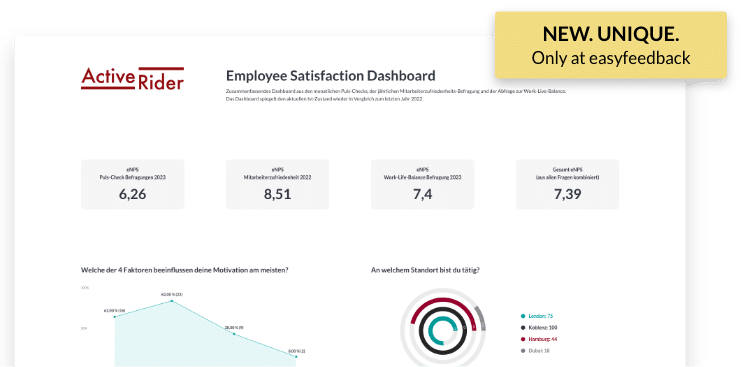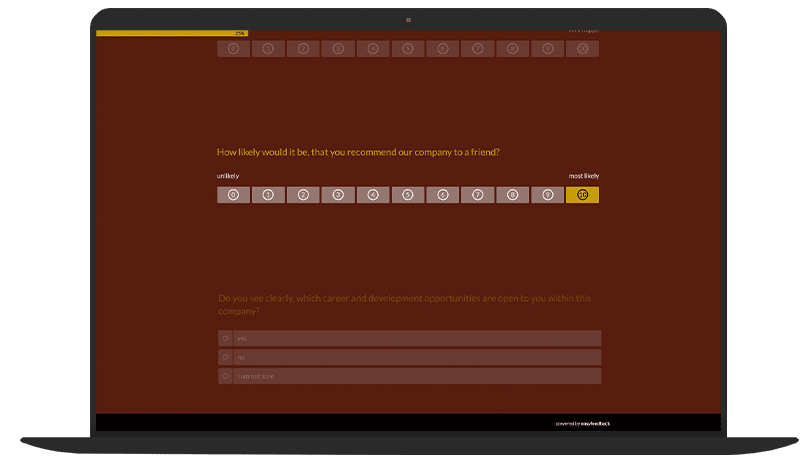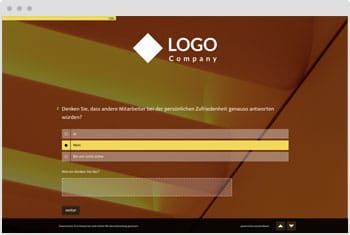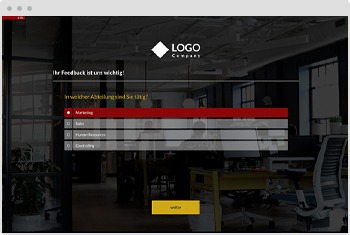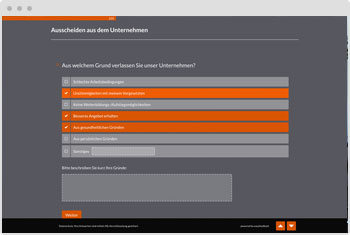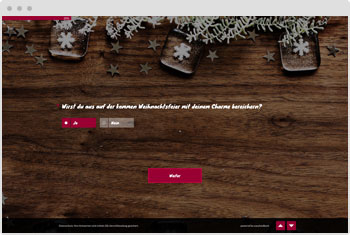Strengthen the employer brand through feedback from employees

With this ready-to-use survey template, you can find out how your company is perceived as an employer. This way you will be able to improve the working atmosphere and satisfaction.

“Identifying customer needs is an essential part of our business. easyfeedback accompanies us for many years as a loyal partner in this task. We particularly appreciate the intuitive usability of the survey tool as well as the professional support.”
Guild Lead User Experience Research
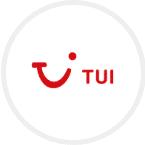
“We use easyfeedback for internal and external surveys – fast, comfortable and really easy! Straightforward and cordial support can always create a smile. We really appreciate the permanent development of the platform.”
Guest & Competitor Insights Analyst
Content and targets of this employer brand template
How attractive is your company for new applicants? Find out how your company is perceived as an employer.
The working atmosphere and employee satisfaction play a decisive role in determining how interesting an employer will be in the future. Change the perspective with a short employee survey.
Identify the key factors of employer attractiveness. Your employees can help you with their individual perceptions.
Ask them why they like working for your company. Are they satisfied with the benefits and conditions offered? Do all areas experience the necessary appreciation? Get an idea of the extent to which corporate values are lived out.
With a questionnaire to determine the attractiveness of an employer, you have the opportunity to strengthen your employer brand and develop it competitively.
Become the employer of choice for talented employees and retain your existing staff by increasing their motivation and satisfaction. Remain attractive as an employer!
Content:
• Company and workplace satisfaction survey
• Appreciation and recognition
• Strengthening attractiveness as an employer
• Determining the level of knowledge about corporate values
Targets:
• Recording the mood among employees
• Feedback on the corporate mission statement from the perspective of employees
• Overview of the different perspectives on corporate culture
• Attracting and retaining talent
• Strengthening and developing the employer brand

Data privacy protection „made in Germany“ (GDPR)

Anonymity functions for open feedback
Almost everything you need to know about the employer brand
1. What is the employer brand?
With an employer brand, a company presents itself as an attractive employer with the help of marketing strategies.
The goal of the company is to positively differentiate itself from competitors on the labor market and to attract new employees, but also to motivate and retain existing employees through the implementation of targeted measures in the area of employee retention. The employer brand contains, in particular, a uniform mission statement with which the company’s values are to be communicated.
If the company succeeds in strengthening the employer brand and thus positioning it well, this can mean an enormous competitive advantage on the labor market.
2. Why is employer attractiveness important for companies?
Companies that present themselves as an attractive employer on the labor market through an employer brand find it easier to find suitable applicants for open positions. This is a major advantage, especially in industries with a lack of skilled workers. A high level of employer attractiveness keeps them in the game in the “war for talents,” i.e., the competition for young, talented workers.
In addition, companies retain their existing staff by increasing their motivation and satisfaction. In this way, they avoid high fluctuation within the company and save costs. Satisfied employees are also more productive, sick less often and enjoy their work, which also benefits the company.
3. What makes a good employer brand?
One important aspect of a good employer brand is addressing the right target group. For example, in order to attract young potential candidates, it makes sense to address them via channels that they also use. This includes social media in particular.
A modern career page on the company’s homepage or image videos can also be a good way to attract the attention of potential new employees. The goal should be to use the employer brand to create positive associations and thus increase the attractiveness of the company as an employer.
Another important aspect is transparency. The channels described above can be used well to gain authentic insights into the company and everyday working life. This can be achieved particularly well through employee testimonials and interviews or even “fun facts” about the company. The more creative, the more likely the company is to stand out from the crowd.
The definition of a mission statement, consisting of the most important corporate values, is also part of a good employer brand. The mission statement should be designed in such a way that the potential candidate, but also the already hired employee, can identify with it. A good employer brand also has an impact on employees who have already been hired. It strengthens the “we” feeling, motivates and retains employees in the long term.
4. How and how can you measure employer attractiveness?
With the help of regular employee surveys or personal interviews, you can easily find out about the current subjective mood of your staff, possible problems, wishes and suggestions, and do this at various points in the employee journey.
For example, you can already ask about the reasons for interest in your company in the application form, which may take the form of a questionnaire, or in the interview itself. If an employee decides to leave the company, you can also find out the possible reasons here with the help of an exit interview.
5. What is the aim of an employer attractiveness survey?
A survey on employer attractiveness initially provides you with a wide range of information: You can capture the mood among employees, get feedback on the corporate mission from the employees’ point of view, and get an overview of the different perspectives on corporate culture.
The results of the questionnaire initially show you where you currently stand (current status). Determine whether there are any points that are consistently rated negatively. This will give you a starting point for improvement. Or do your employees praise one aspect in particular? Then use and communicate this aspect of your employer brand to attract potential new employees.
In this way, you strengthen your employer brand and develop it further. This increases your attractiveness as an employer, which in turn attracts new talent to your company.
6. Which groups of people can I ask about the attractiveness of my employer brand?
Three groups of people are suitable for a survey on the attractiveness of the employer brand. These are employees already employed by the company, former employees and potential new employees.
The potential new employees are external people who have no previous connection with the company. Therefore, it is more difficult to find suitable candidates for the survey. One possibility is to survey high school or college students. An interesting target group here could be students from the company’s specialist area.
From the results, you can particularly derive insights into how well known your employer brand already is. Do the respondents know your company? If not, this means that you can further expand awareness of your company with the help of the employer brand.
7. What questions about employer attractiveness can I ask in the survey?
Since every company is unique, there is no single questionnaire that fits every company. However, you can use the following questions as a guide when creating your questionnaire:
Internal company questions about the employer brand:
- How satisfied are you with the company and your job?
- Do you receive enough appreciation and recognition?
- How can we strengthen our attractiveness as an employer? What do you want from us?
- Can you identify with our corporate values?
- Would you recommend our company as an employer to a friend or family member?
Questions external to the company about the employer brand:
- Do you know our company?
- How did you become aware of our company?
- Do you know our company mission statement?
- Could you imagine working for us?
- What could we improve in your view to become more attractive to you as an employer?
8. Should I conduct the questionnaire to measure employer attractiveness anonymously or personalized?
We recommend that participation in employee surveys should generally be anonymous. There are several reasons for this:
Employees are generally more willing to participate if they do not feel that their answers could be traced and that they could be threatened with negative consequences as a result. Anonymity increases trust in the survey and leads to another important point, more honest and meaningful responses. This is exactly what is important if you want to measure your employer brand and positively optimize it through measures. Only if you know what employees dislike about your company or what they would like to see in order to increase motivation and willingness to perform, then you too can implement positive changes through suitable measures.
Another aspect is the existence of a works council within the company. This council is more likely to agree to the implementation of an employee survey for the protection of employees if participation in the survey is anonymous.
9. What can the process of an employer branding survey look like?
If you decide to strengthen your attractiveness as an employer with the use of surveys to attract new talent, reduce employee turnover and increase employee retention, the following process for conducting them may be of help:
Step 1: Define the objective
Before starting the survey project, the first step should be to define the objective of the project. It is not sufficient to set the goal of increasing attractiveness as an employer. That is too vague and too broad. The goal should be defined more precisely.
For example, if your goal is to strengthen the employer brand in order to positively influence employee retention, then the design of the questionnaire as well as the questions it contains will be different than if the goal is to improve the chances of recruiting new talent and employees in the “war of talents” in the future.
Therefore, the goal shapes the questionnaire!
Step 2: Clarify the framework conditions
Once the goal of the survey project has been defined, the next step is to define the framework conditions for it. Questions such as: “How should the survey be conducted?”, “Who should be surveyed?”, “When should the survey be conducted?”, “Should the survey be personalized or anonymous?” and “What are the obstacles to the implementation of a survey?” should be clarified in this phase, because they are important for the creation and organizational implementation.
Only when the general conditions have been clarified should the next step be to start building and designing the questionnaire.
Step 3: Building the questionnaire
Once the goal and the framework conditions have been clarified, the next step is to build the questionnaire and develop suitable questions to measure current employer attractiveness and find ways to increase it. Introduction, main section and conclusion form a good basic framework for the questionnaire. Form topic blocks for questions that ask about an aspect of employer attractiveness and try to work with simple wording and question types that are not too complex and allow for a quick response.
But an appealing design and the length of the questionnaire are also important factors that play a decisive role in the success of the survey.
Step 4: Conduct the survey
After the design and successful pre-testing of the questionnaire, it is now time to carry out the survey. This means educating the participants in advance about the goal and possible benefits of participating in the survey, inviting them to take the questionnaire, and then hoping that they will participate.
But educating and inviting is not the only part of implementation. There should also be checks throughout the survey period and especially at the beginning to see how many have already participated, what the dropout rate is when using online questionnaires, and also where most dropouts happen.
In the implementation, it is also a matter of recognizing whether there may be problems during the answering of the questionnaire, for example because questions are not understandable or the answer options are perhaps not suitable for the question. But also the length of the questionnaire can be a problem.
If difficulties arise during the survey, adjustments should be made early on. This tends to be difficult with paper-based surveys, but with digital questionnaires, the adjustment can happen immediately.
Step 5: Evaluate feedback
Once the survey period is over and you feel that enough participants have taken part, it’s time to evaluate the employee feedback received. Using diagrams, filters and comparisons, you should try to discover similarities and differences between departments and employees and, in the case of open questions, read between the lines. With a good evaluation, you can lay the foundation for defining appropriate measures to enhance the employer brand.
Step 6: Repeat survey
Questionnaire completed, feedback evaluated, measures implemented and now the employer branding project is over?
No, at this point you should now check the implemented measures for effectiveness. This is best done with further feedback. You should not forget that improving the attractiveness of the employer brand is not a quick and one-time thing. Only continuity and permanent improvement through feedback will lead to greater employer attractiveness in the long term. This can be created with the establishment of a feedback culture in the company, and not only for the goal of increasing employer attractiveness, but also for many other topics, such as improving internal communication or determining the training needs of employees.
10. Are there examples and ideas on how to strengthen the employer brand?
There are. In fact, internal as well as external measures can strengthen your own employer brand. We have explained a few ideas and examples in more detail below:
The first and most important idea for increasing employer attractiveness is to satisfy your own employees yourself and use them as brand ambassadors. Nothing is more credible than when your own employees positively recommend the company as an employer to friends and family. Therefore, make regular employer branding surveys in your company to always measure the current mood and attractiveness.
Furthermore, you can present yourself as an attractive employer through social commitment in the region. This will give your employer brand a positive influence among both your employees and potential employees.
A third idea to improve your company’s employer branding would be to participate in external events such as career fairs or to organize your own events, for example an open day for recruiting future junior staff.
Strengthening the employer brand is also possible through a presence on employer rating portals as well as on social media. Social media can be a credible and fun way to build a bond with employees and potential applicants and recruit new talent by posting news and using images and video. Even though these portals tend to be viewed critically by companies due to the high incidence of fake reviews or reviews made out of frustration, the feedback given there can also be helpful in strengthening the employer brand. The one or other seriously meant assessment still exists and that is exactly where possible potential for improvement lies.
The last possible idea to increase the attractiveness as an employer are awards in the form of employer seals. As a certified employer, you enjoy a number of advantages and demonstrate authenticity through the seal.
You are in professional company







easyfeedback welcomes more than 740.000 participants per month!
